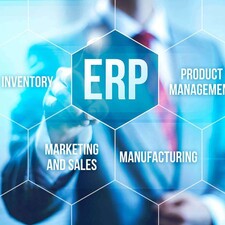Blog
The Ultimate Guide to SaaS ERP

Summary
SaaS ERP models are gaining a foothold in the enterprise resource planning sector, giving businesses an opportunity to leverage robust technological solutions in a more accessible, cost-efficient ecosystem. The move to SaaS-based ERP systems is well underway, but it comes with a few caveats that organizations must be prepared to deal with as they select solutions and define their big-picture strategies.
Why Move to SaaS-based ERP Systems?
Businesses are facing mounting pressure to pursue digital transformation initiatives and integrate data into everyday decision-making processes. This trend is moving so quickly that the market for solutions that drive digital transformation will grow to $798.44 billion by 2025, Grand View Research found.
According to the study, new technologies are emerging quickly to help businesses shift their business models around the capabilities offered by digital technologies, forcing companies to rethink how they manage and use data.
All of the information in the world isn't useful if employees can't leverage that data in line with the work they're doing. ERP solutions are designed to create a single source of data truth and put that information in the hands of users as they work. SaaS-based solutions take this functionality to another level by expanding the ERP ecosystem out to mobile devices using modern interfaces that fuel productivity.
Understanding the Cloud ERP Market
Cloud computing is becoming a dominant IT service delivery model across a variety of sectors. In simplest terms, the cloud turns technology spending into an ongoing payment for a subscription. The server and storage assets are housed in a third-party data center, where the vendor manages, updates and maintains the solution, delivering it through the web.
SaaS makes data and app interfaces available through any connected device
The cloud hosting model eliminates the bulk of the capital expenses that come with making major tech investments. While the cloud can be used in a variety of service methodologies, SaaS is among the most dominant. SaaS uses the underlying cloud model to deliver applications to end users via the internet, making data and app interfaces available through any connected device. As a result, employees can work from any location where they can access the web without having to sacrifice functionality.
When these capabilities come together, organizations can use SaaS-based solutions to:
-
Access sophisticated software that would normally be too expensive for a large one-time purchase.
-
Eliminate IT overhead by moving management and updates to the cloud vendor.
-
Establish remote work methodologies that allow for greater flexibility and responsiveness.
-
Upgrade and shift between solutions more easily because companies don't have to migrate hardware, just data.
These benefits are fueling the rapid adoption of SaaS-based technologies across a variety of verticals. According to Transparency Market Research, the global SaaS market will be valued at approximately $164.3 billion by 2022. To reach this high valuation, the sector will expand at a compound annual growth rate of 27.9 percent from 2015 through 2022.
SaaS's growing dominance is extending into the ERP space, where companies are increasing their use of the technology as it matures and businesses move away from entrenched legacy systems. Deloitte found that businesses are moving quickly to adopt cloud ERP systems in order take advantage of emerging capabilities while establishing a basis for ongoing innovation.
According to Deloitte, cloud computing is unlocking a variety of key capabilities in the ERP sector, for example by empowering users to leverage wireless and mobile solutions, create more advanced interfaces, increase the use of analytics and become more flexible. Specific to SaaS, the research firm found that the technology is allowing for greater personalization and driving security gains as it matures. Furthermore, SaaS-based ERP is enabling companies to change their business processes with relative ease.

It can be tempting for small- to mid-sized companies to think they would benefit from an ERP system, but wouldn't get enough value out of the technology to justify the cost and complexity. SaaS breaks those barriers down. In fact, a Market Research Engine study found that the increased demand for ERP solutions among small- and medium-sized businesses is among the primary growth factors in the industry moving forward.
Cloud computing is bringing ERP functionality to a wider range of companies, driving significant growth opportunities in the sector moving into the coming years. As ERP solutions continue to evolve, businesses must look for systems offering the adaptability to stay apace with today's emerging technologies, including the internet of things and artificial intelligence. If your company is among those trying to keep up in increasingly complex operational settings, a SaaS ERP could be a natural fit for you.
Implementing a Cloud-based SaaS ERP Solution
ERP implementation has historically been a long and complex process, as businesses are forced to install supporting infrastructure, deal with sophisticated data integration tasks and thoroughly test the new ERP setup within their IT configuration. Moving to the cloud simplifies many of these tasks. The platform itself is hosted by the service provider and delivered via the internet, freeing you from having to make major changes to your data center and IT systems. You may want to make some network upgrades to support increased data moving through the business, but that's much simpler than reconfiguring IT configurations.
Modern cloud ERP solutions and mobile-optimized ERP apps simplify implementation in numerous ways
Furthermore, the modular nature of most cloud ERP systems means you can deploy ERP applications, such as mobile versions of the software, that provide flexibility for users without creating added technical overhead. The result is a much smoother deployment process at the outset. There can still be some integration hurdles to deal with, but many modern solutions address that through APIs that function as middleware between your ERP system and dedicated hardware supporting different lines of business. On the whole, modern cloud ERP solutions and the mobile-optimized ERP applications they offer simplify implementation in numerous ways.
What to Expect From SaaS ERP
An ERP system serves as a database that underpins business processes. Because of this, it is incredibly important to consider more than just the technical side of the situation, but also the way that you use information alongside your day-to-day operations. For example, an ERP system in a manufacturing firm will typically include modules for finance, inventory management, vendor management, and production, among other features, because production processes depend particularly heavily on data from those parts of the business.
When the sales team processes an order, it will input that data into the ERP so the production team can schedule it. From there, warehouse teams can manage inventory levels relative to the work orders on hand, finance teams can process orders and invoices based on centralized data and decision-makers can identify vendor performance using a single source of data pulled from across the business. In short, the ERP solution interconnects disparate data in one place and presents it in interfaces that are relevant to specific user groups.
On top of all this, an ERP solution can also integrate with specialized solutions, such as a customer relationship management or e-commerce platform. This lets organizations integrate data across lines of business.
Don't get overwhelmed with your ERP selection process. Get help by downloading the Guide to the 7 Easy Steps of ERP Selection

Traditionally, companies leveraging ERP have done so by building out monolithic internal platforms that require significant amounts of maintenance and attention. While hosting an ERP system on site came with many costs and complexities, it also gave organizations freedom to customize and adjust the system to their specific needs. In fact, open source ERP platforms – solutions with open source code that allows for sweeping changes to the software – have become popular as organizations look to gain a great deal of alignment between their technology solutions and business demands.
While this level of customization is attractive, the high costs and resource demands of a traditional ERP solution have driven many organizations to turn to SaaS-based models. With SaaS, you can roll out an ERP platform in a fraction of the time of a traditional system. However, it is important to carefully evaluate what you are getting when you switch to a SaaS solution.
You can't always expect a SaaS ERP platform to be as powerful as a premise-based solution. Some ERP providers will use the cloud to host a bare-bones solution meant as an entry-level option, but with limited ability to grow alongside your business. The cloud offers scalability, but companies don't just need to expand their ERP systems as they grow. Businesses also need flexibility to refine and adjust their processes.
As a baseline, you can expect a SaaS ERP system to allow for mobile access, offer accessibility across lines of business and simplify backend management. With abas, you can expect more.

The abas SaaS ERP advantage
We've built our SaaS ERP solution with a modular underlying framework that allows organizations to perform deep customization based on their specific needs. In essence, you can create the workflows, processes and data integrations you need without having to tamper with the core ERP module, giving you the flexibility you need without the complexity of a premises-based system.
The other problem many ERP platforms have is porting the software onto mobile. Vendors will sometimes limit functionality on smartphones and tablets or simply use the desktop interface on mobile, making it a hassle for end users. We've built abas ERP with a mobile-optimized interface that also works effortlessly on web or desktop, ensuring a common user experience.
The SaaS model is beginning to transform the ERP sector, making the sophisticated technology accessible to a wider range of businesses and use cases. But not every SaaS ERP system is created equal. At abas, we have always prided ourselves on engineering excellence as we've built our ERP modules from scratch to work with one another. We've brought this expertise to our SaaS solution, providing the flexibility and power of a traditional ERP setup in the cloud.
If your business is among the many organizations scrambling to respond to the demands of digital customers and operational models, you need an ERP system with a blend of accessibility and flexibility. abas delivers this balance through our unique SaaS ERP solution. Contact us today to learn more.


